Themed collection Editor’s Choice: Tissue Engineering

Materials Horizons, Journal of Materials Chemistry B and Materials Advances Editor's Choice Web Collection: Recent Advances in Tissue Engineering Scaffolds
This Editor's collection introduces some scaffold-related reviews and research articles that have been recently published in Materials Horizons, Journal of Materials Chemistry B and Materials Advances.

Mater. Horiz., 2022,9, 2021-2023
https://doi.org/10.1039/D2MH90051C
Leveraging the advancements in functional biomaterials and scaffold fabrication technologies for chronic wound healing applications
The graphic displays various biomaterial design functionalities along with the developed fabrication technologies to enhance the wound healing process in patients with chronic wounds.
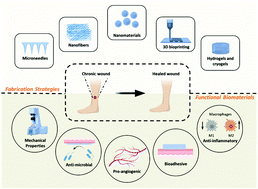
Mater. Horiz., 2022,9, 1850-1865
https://doi.org/10.1039/D2MH00115B
Polyphenol scaffolds in tissue engineering
This review focuses on the recent advances in polyphenol-based scaffolds including their structural and functional features, fabrication strategies, and various applications in tissue engineering.
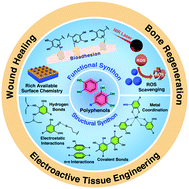
Mater. Horiz., 2021,8, 145-167
https://doi.org/10.1039/D0MH01317J
Additive manufacturing of natural biopolymers and composites for bone tissue engineering
Through additive manufacturing (AM) of natural biopolymers, significant progress has been made in the field of biomedical devices and bone tissue engineering of low load bearing applications like maxillofacial, bone defects, and dental.

Mater. Horiz., 2020,7, 2011-2027
https://doi.org/10.1039/D0MH00277A
Direct-writing microporous polymer architectures – print, capture and release
Direct-writing of droplets onto fluid surfaces by inkjet printing to dial-in a required pattern, structure and function into a polymer film.

Mater. Horiz., 2021,8, 179-186
https://doi.org/10.1039/D0MH01460E
Triggered micropore-forming bioprinting of porous viscoelastic hydrogels
This work reports a novel approach to 3D-bioprint hierarchical cell-laden scaffolds with an unprecedented combination of porous and viscoelastic properties.
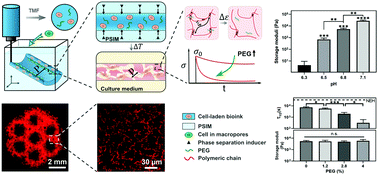
Mater. Horiz., 2020,7, 2336-2347
https://doi.org/10.1039/D0MH00813C
High-throughput fabrication of cell-laden 3D biomaterial gradients
A fully high-throughput (HT) microfluidic platform for the generation of novel multi-material, multi-crosslinking 3D cell-laden gradients as screening libraries.
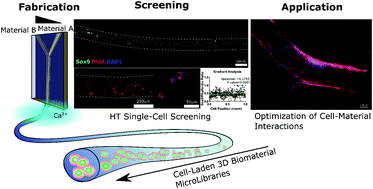
Mater. Horiz., 2020,7, 2414-2421
https://doi.org/10.1039/D0MH00818D
Preparation of mesh-like collagen scaffolds for tissue engineering
Collagen meshes with large or small openings were prepared after selective removal of PLGA mesh from PLGA–collagen composite mesh or collagen-coated PLGA mesh. The collagen meshes support human skin fibroblast adhesion and promote cell proliferation.
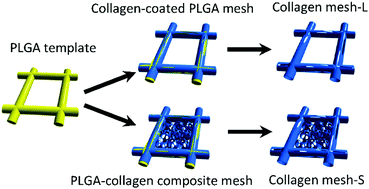
Mater. Adv., 2022,3, 1556-1564
https://doi.org/10.1039/D1MA01166A
Microwave-assisted methacrylation of chitosan for 3D printable hydrogels in tissue engineering
The microwave-assisted methacrylation of chitosan is studied. The control of the process parameters allows tuning the methacrylation degree and thus the hydrogel properties after photocuring. The resulting chitosan is 3D printable and biocompatible.

Mater. Adv., 2022,3, 514-525
https://doi.org/10.1039/D1MA00765C
Plasma assisted design of biocompatible 3D printed PCL/silver nanoparticle scaffolds: in vitro and in vivo analyses
3D printing provides numerous opportunities for designing tissue engineering constructs with intricate porosity, geometry and favourable mechanical properties and has the potential to revolutionize medical treatments.

Mater. Adv., 2021,2, 6620-6630
https://doi.org/10.1039/D1MA00444A
Synthesis and characterization of β-cyclodextrin/carboxymethyl chitosan/hydroxyapatite fused with date seed extract nanocomposite scaffolds for regenerative bone tissue engineering
A first report on the fabrication of nanocomposite scaffolds containing nano-hydroxyapatite/carboxymethyl chitosan/β-cyclodextrin heterojunctions fused with date seed extract for bone tissue engineering applications.

Mater. Adv., 2021,2, 5723-5736
https://doi.org/10.1039/D1MA00286D
An in situ gelling BMSC-laden collagen/silk fibroin double network hydrogel for cartilage regeneration
An in situ fast-forming BMSC-laden Col-PEG/SF hydrogel with short gelation time, great biocompatibility and good mechanical properties was fabricated for cartilage regeneration.
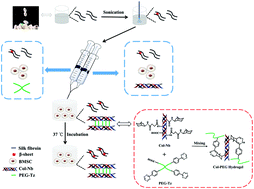
Mater. Adv., 2021,2, 4733-4742
https://doi.org/10.1039/D1MA00285F
Elaboration and mechanical properties of elastomeric fibrous scaffolds based on crosslinked poly(glycerol sebacate) and cyclodextrin for soft tissue engineering
An elastomeric scaffold containing poly(glycerol sebacate) and hydroxypropyl-β-cyclodextrin was developed for soft tissue engineering.

Mater. Adv., 2021,2, 1284-1293
https://doi.org/10.1039/D0MA00673D
IFN-γ/SrBG composite scaffolds promote osteogenesis by sequential regulation of macrophages from M1 to M2
The macrophage-dominated bone immune response plays an important role in osteogenesis of bone defects.
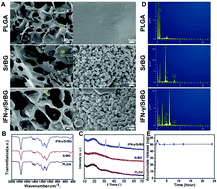
J. Mater. Chem. B, 2021,9, 1867-1876
https://doi.org/10.1039/D0TB02333G
Dual-enzymatically cross-linked gelatin hydrogel enhances neural differentiation of human umbilical cord mesenchymal stem cells and functional recovery in experimental murine spinal cord injury
A dual-enzymatically cross-linked gelatin hydrogel is proposed to undergo direct neuronal differentiation of hUC-MSCs for promoting regeneration of spinal cord injury mice.
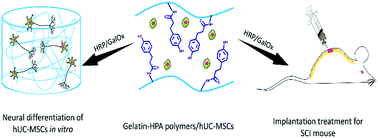
J. Mater. Chem. B, 2021,9, 440-452
https://doi.org/10.1039/D0TB02033H
Mechanically tunable elastomer and cellulose nanocrystal composites as scaffolds for in vitro cell studies
Composites based on ε-caprolactone-D,L-lactide-based elastomer with cellulose nanocrystals (CNC) are investigated to understand how matching cells with appropriate mechanical environments can provide important insights into fundamental cell behaviors.
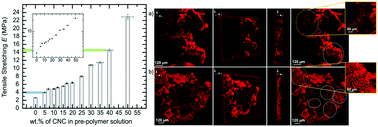
Mater. Adv., 2021,2, 464-476
https://doi.org/10.1039/D0MA00676A
A biodegradable block polyurethane nerve-guidance scaffold enhancing rapid vascularization and promoting reconstruction of transected sciatic nerve in Sprague-Dawley rats
Schematic of nerve guidance scaffold for reconstruction of peripheral nerve defects in Sprague-Dawley rats.
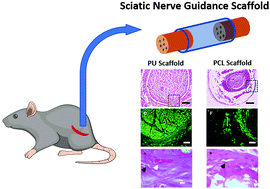
J. Mater. Chem. B, 2020,8, 11063-11073
https://doi.org/10.1039/D0TB02069A
Graphene oxide-functionalized nanofibre composite matrices to enhance differentiation of hippocampal neuronal cells
The neurite outgrowth was guided by biofunctional cues, such as Lam and GO, with nanofibre-mediated topographical cues, which upregulated the expression of some specific genes closely associated with cytoskeletal interactions.
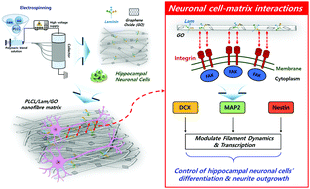
Mater. Adv., 2020,1, 3496-3506
https://doi.org/10.1039/D0MA00733A
Development of Fe3O4 integrated polymer/phosphate glass composite scaffolds for bone tissue engineering
A multifunctional Fe3O4 integrated polymer/phosphate glass composite scaffold is developed using a freeze drying technique for tissue engineering.

Mater. Adv., 2020,1, 3466-3475
https://doi.org/10.1039/D0MA00525H
Reduced graphene oxide–GelMA–PCL hybrid nanofibers for peripheral nerve regeneration
Graphene oxide is currently used in peripheral nerve engineering but has certain limitations, such as cytotoxicity and lack of electrical conductivity, both of which are crucial in regulating nerve-associated cell behaviors.
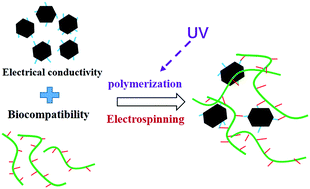
J. Mater. Chem. B, 2020,8, 10593-10601
https://doi.org/10.1039/D0TB00779J
Nanofiber-reinforced bulk hydrogel: preparation and structural, mechanical, and biological properties
Facile preparation of nanofiber-reinforced bulk hydrogel, which is suitable as a biomaterial due to its improved mechanical and biological properties.

J. Mater. Chem. B, 2020,8, 9794-9803
https://doi.org/10.1039/D0TB01948H
Rapid and cytocompatible cell-laden silk hydrogel formation via riboflavin-mediated crosslinking
A novel methodology for the development of cell-laden silk hydrogels using a biocompatible photo-initiator.
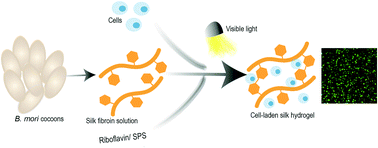
J. Mater. Chem. B, 2020,8, 9566-9575
https://doi.org/10.1039/D0TB01731K
Development of an antibacterial nanocomposite hydrogel for human dental pulp engineering
Nanocomposite fibrin-based hydrogel with antibacterial and antibiofilm properties, safe for dental pulp mesenchymal stem cells.
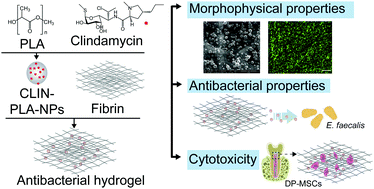
J. Mater. Chem. B, 2020,8, 8422-8432
https://doi.org/10.1039/D0TB00989J
Acrylate–gelatin–carbonated hydroxyapatite (cHAP) composites for dental bone-tissue applications
The favourable properties of acrylate–gelatin–cHAP composites fabricated via copolymerization reaction may make possible porosity and hydrophilicity remodelling and thus promote scaffold-implant integration.
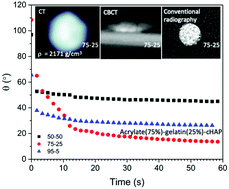
Mater. Adv., 2020,1, 1675-1684
https://doi.org/10.1039/D0MA00498G
Biocompatible polypeptide-based interpenetrating network (IPN) hydrogels with enhanced mechanical properties
Herein, we present the synthesis of novel synthetic polypeptide-based interpenetrating network (IPN) hydrogels with enhanced mechanical properties, and biocompatability.
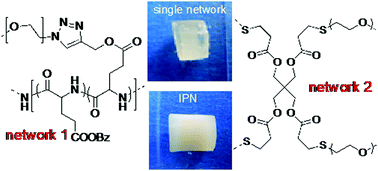
J. Mater. Chem. B, 2020,8, 7785-7791
https://doi.org/10.1039/D0TB01422B
Construction of self-assembled nanostructure-based tetraphenylethylene dipeptides: supramolecular nanobelts as biomimetic hydrogels for cell adhesion and proliferation
A novel TPE-YY peptide hydrogelator self-assembled to form twisted nanobelts at neutral pH, upon cultured with 3A6 cells showed selective cell adhesion and growth.
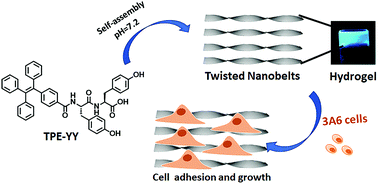
J. Mater. Chem. B, 2020,8, 7483-7493
https://doi.org/10.1039/D0TB01147A
Engineered macroporous hydrogel scaffolds via pickering emulsions stabilized by MgO nanoparticles promote bone regeneration
A novel macroporous composite hydrogel scaffolds were developed by using Pickering emulsions stabilized by MgO NPs for application in the field of bone regeneration.
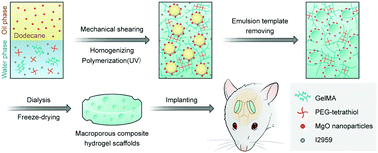
J. Mater. Chem. B, 2020,8, 6100-6114
https://doi.org/10.1039/D0TB00901F
HBC-nanofiber hydrogel scaffolds with 3D printed internal microchannels for enhanced cartilage differentiation
HBC-nanofiber hydrogel scaffolds with 3D printed internal microchannels have been developed to provide a multifunctional biomimetic microenvironment for hMSC chondrogenesis.
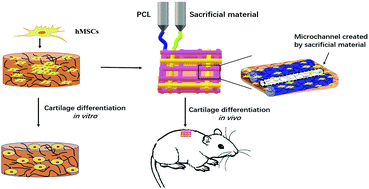
J. Mater. Chem. B, 2020,8, 6115-6127
https://doi.org/10.1039/D0TB00616E
3D printing of cell-laden electroconductive bioinks for tissue engineering applications
Bioprinting is an emerging powerful fabrication method, which enables the rapid assembly of 3D bioconstructs with dispensing cell-laden bioinks in pre-designed locations.
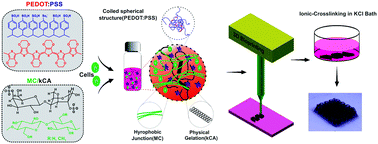
J. Mater. Chem. B, 2020,8, 5862-5876
https://doi.org/10.1039/D0TB00627K
Osteopontin sequence modified mesoporous calcium silicate scaffolds to promote angiogenesis in bone tissue regeneration
Surface grafting and encapsulation of SVVYGLR peptides in MCS promote vessel/bone formation all over the scaffold.
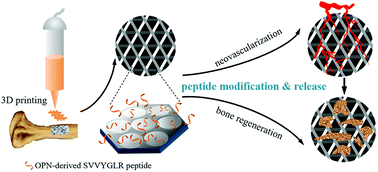
J. Mater. Chem. B, 2020,8, 5849-5861
https://doi.org/10.1039/D0TB00527D
Magnetic lanthanum-doped hydroxyapatite/chitosan scaffolds with endogenous stem cell-recruiting and immunomodulatory properties for bone regeneration
Magnetic lanthanum hydroxyapatite/chitosan scaffolds can better repair bone defects through stem cell recruitment and immunomodulation.

J. Mater. Chem. B, 2020,8, 5280-5292
https://doi.org/10.1039/D0TB00342E
About this collection
To mark the transition from an Associate Editor role on Journal of Materials Chemistry B and Materials Advances to a Scientific Editor role on Materials Horizons, Guoping Chen (National Institute for Materials Science, Japan) has selected some outstanding recent manuscripts on tissue engineering for this Editor’s Choice collection. In order to highlight developments in materials for tissue engineering applications, this online collection includes recent articles and reviews from Materials Horizons, Journal of Materials Chemistry B and Materials Advances on the topic.